Compaction Effort Evaluation of Crumb Rubber Modified Hot Mix Asphalt
Abstract
:1. Introduction
2. Goals and Objectives
Limitations
3. Materials and Methods
Sample Preparation
- Modified bitumen with CR was prepared by mixing bitumen with CR prior to mixing with aggregate at 160–200 °C for 45 min; this was known as the wet process [31].
- In total, 64 Superpave Marshall samples were prepared for each source used in the study for the design aggregate structure (DAS), design asphalt content (DAC), optimum asphalt content (OAC), optimum crumb rubber content (OCRC), Marshall stability, indirect tensile strength test (ITS), and index of retained strength test (IRS), as shown in Figure 2.
4. Results and Discussion
4.1. Selection of Design Aggregate Structure (DAS)
- Source A: Trial blends 1 and 2 failed the voids filled with asphalt (VFA) criteria. However, these two blends were created with high compaction effort. It is clear in Table 3 that trial blend 3 had all the criteria; therefore, trial blend 3 was selected as a DAS.
- Source B: Trial blend 3 failed the percentage of voids in mineral aggregate (VMA) criteria. However, this trial blend was created with high compaction effort. It is shown in Table 3 that trial blends 1 and 2 had all the criteria, but only one trial blend was needed. Therefore, on the basis of the closest values of VMA and VFA to the criteria, it can be observed in Table 3 that trial blend 2 had closer values than trial blend 1; thus, trial blend 2 was selected as a DAS.
- Source C: All the trial blends passed the requirements of the Superpave criteria, but in order to choose the best one, it was recommended to select trial blend 1 because all the parameters that were determined in terms of the volumetric analysis were close to the required criteria. Therefore, trial blend 1 was selected as a DAS.
4.2. Selection of Design Asphalt Content (DAC)
- Estimated asphalt content;
- Estimated asphalt content ± 0.50%;
- Estimated asphalt content + 1.0%.
4.3. Optimum Crumb Rubber Content (OCRC) Determination
4.4. Relationships between SGC and MIH
4.4.1. Relationship on the Basis of Marshall Stability
- Source A: In order to achieve the same Marshall stability value as the Superpave unmodified sample, the MIH required 78 blows (28 extra blows). However, the modified sample at 9 percent OCRC only required 64 blows (14 extra blows).
- Source B: In order to achieve the same Marshall stability value as the Superpave unmodified sample, the MIH required 70 blows (20 extra blows). In addition, the modified sample at 9 percent OCRC required 74 blows (24 extra blows).
- Source C: In order to achieve the same Marshall stability value as the Superpave unmodified sample, the MIH sample required 68 blows (18 extra blows). In addition, the modified sample at 9 percent OCRC required 72 blows (22 extra blows).
4.4.2. Relationship on the Basis of Density
4.5. Moisture Sensitivity
4.5.1. Indirect Tensile Strength (ITS)
4.5.2. Index of Retained Strength (IRS)
Effect of the Number of Blows and Gyrations on the Compressive Strength
Effect of CRM on the IRS at Different Numbers of Blows and Gyrations
Effect of CRM on Compressive Strength
5. Conclusions
- The percentage of the optimum asphalt content determined using the Superpave mix design was lower than that determined using the Marshall mix design for the three sources used in this study. This reveals that the Superpave mix design is more economical.
- In comparison to the Marshall mix design, the Superpave mix design provided the highest level of stability for all sources. However, at 9 percent CRM, both mix designs provided maximum stability. Therefore, 9 percent CR was selected as the OCRC in this study.
- Based on the various numbers of blows and gyrations, the Superpave mix design provided higher stability than the Marshall mix design for the three sources that were used and even for the modified mixtures at the OCRC.
- The Superpave mix design provided higher tensile and compressive strengths than the Marshall mix design for the unmodified and modified mixtures, whereas the modified mixtures provided greater tensile and compressive strengths than the unmodified mixtures.
- Because of the excellent performance (stability, density, indirect tensile strength, and compressive strength) achieved by the SGC for the unmodified and modified mixtures at the OCRC, it was important to attain the same performance using the MIH at Ndesign. The average numbers of extra blows (after 50 blows) required by the Marshall samples to obtain the same performance as with the Superpave samples, based on the three sources that were used, were approximately 21 extra blows for stability, 21 extra blows for density, 18 extra blows for tensile strength, and 24 extra blows for compressive strength.
- The superiority of the Superpave compaction method using the SGC over the MIH was due to the effect of kneading during compaction, which increased the shear strength of the mixture and improved the tensile and compressive strengths of the asphalt mixture.
- The Marshall samples failed to satisfy the 80 percent criteria of the IRS at four compaction levels from unmodified sources A, B, and C, while the Superpave samples satisfied these criteria for all compaction levels from all the sources that were used.
- In addition to increasing the compressive strength in the range from 16 to 48 percent, CRM also provided a higher IRS percentage than the unmodified mixtures. This allowed the mixtures to have more resistance to permanent deformation and moisture damage.
Author Contributions
Funding
Institutional Review Board Statement
Informed Consent Statement
Data Availability Statement
Acknowledgments
Conflicts of Interest
References
- Qian, G.; Hu, K.; Li, J.; Bai, X.; Li, N. Compaction process tracking for asphalt mixture using discrete element method. Constr. Build. Mater. 2020, 235, 117478. [Google Scholar] [CrossRef]
- Huerne, H.L.T.; Van Maarseveen, M.F.; Molenaar, A.A.; Van De Ven, M.F. Simulation of HMA compaction by using FEM. Int. J. Pavement Eng. 2008, 9, 153–163. [Google Scholar] [CrossRef]
- Liu, P.; Hu, J.; Falla, G.C.; Wang, D.; Leischner, S.; Oeser, M. Primary investigation on the relationship between microstructural characteristics and the mechanical performance of asphalt mixtures with different compaction degrees. Constr. Build. Mater. 2019, 223, 784–793. [Google Scholar] [CrossRef]
- Memon, N.A. Comparison Between Superpave Gyratory and Marshall Laboratory Compaction Methods. Doctoral Dissertation, Universiti Teknologi, Johor Bahru, Malaysia, 2006. [Google Scholar]
- Hu, W.; Jia, X.; Huang, B.; Park, H. Evaluation of compactability of asphalt mixture utilizing asphalt vibratory compactor. Constr. Build. Mater. 2017, 139, 419–429. [Google Scholar] [CrossRef]
- Gong, F.; Liu, Y.; Zhou, X.; You, Z. Lab Assessment and Discrete Element Modeling of Asphalt Mixture During Compaction with Elongated and Flat Coarse Aggregates. Constr. Build. Mater. 2018, 182, 573–579. [Google Scholar] [CrossRef]
- Blankenship, P.B.; Mahboub, K.C.; Huber, G.A. Rational Method for Laboratory Compaction of Hot-Mix Asphalt (with Discussion and Closure); Transportation Research Record: Washington, DC, USA, 1994. [Google Scholar]
- Aho, B.D.; Vavrik, W.R.; Carpenter, S.H. Effect of Flat and Elongated Coarse Aggregate on Field Compaction of Hot-Mix Asphalt. Transp. Res. Rec. 2001, 1761, 26–31. [Google Scholar] [CrossRef]
- Chen, J.; Huang, B.; Chen, F.; Shu, X. Application of discrete element method to Superpave gyratory compaction. Road Mater. Pavement Des. 2012, 13, 480–500. [Google Scholar] [CrossRef]
- Mashaan, N.S.; Ali, A.H.; Karim, M.R.; Abdelaziz, M. Effect of blending time and crumb rubber content on properties of crumb rubber modified asphalt binder. Int. J. Phys. Sci. 2011, 6, 2189–2193. [Google Scholar]
- Lee, S.J.; Amirkhanian, S.N.; Putman, B.J.; Kim, K.W. Laboratory study of the effects of compaction on the volumetric and rutting properties of CRM asphalt mixtures. J. Mater. Civ. Eng. 2007, 19, 1079–1089. [Google Scholar] [CrossRef]
- Favakeh, M.; Bazgir, S.; Karbasi, M.; Alavi, M.Z.; Abdi, A. Evaluation of elastomer–plastomer vulcanised modifiers for using as bitumen binder modifier. Int. J. Pavement Eng. 2022, 23, 148–159. [Google Scholar] [CrossRef]
- Wang, H.; Zhang, H.; Liu, X.; Apostolidis, P.; Erkens, S.; Skarpas, A.; Airey, G. Micromechanics-based viscoelasticity predictions of crumb rubber modified bitumen considering polymer network effects. Transp. Res. Rec. 2022, 2676, 73–88. [Google Scholar] [CrossRef]
- Wang, H.; Lu, G.; Feng, S.; Wen, X.; Yang, J. Characterization of bitumen modified with pyrolytic carbon black from scrap tires. Sustainability 2019, 11, 1631. [Google Scholar] [CrossRef]
- Kot, B.; Yilmaz, M.; Geckil, A. Evaluation of low-temperature and elastic properties of crumb rubber–and SBS-modified bitumen and mixtures. J. Mater. Civ. Eng. 2013, 25, 257–265. [Google Scholar]
- Qadr, D.B.; Talabany, A.F.; Yaseen, S.A. Evaluation on the Performance of Hot Mix Asphalt (HMA) Using Polymer Modifications. Erbil. 2021. Available online: https://conferences.cihanuniversity.edu.iq/index.php/ACES/2020/paper/view/296 (accessed on 26 April 2021).
- Palit, S.K.; Reddy, K.S.; Pandey, B.B. Laboratory evaluation of crumb rubber modified asphalt mixes. J. Mater. Civ. Eng. 2004, 16, 45–53. [Google Scholar] [CrossRef]
- Wang, H.; You, Z.; Mills-Beale, J.; Hao, P. Laboratory evaluation on high temperature viscosity and low temperature stiffness of asphalt binder with high percent scrap tire rubber. Constr. Build. Mater. 2012, 26, 583–590. [Google Scholar] [CrossRef]
- Mohajerani, A.; Burnett, L.; Smith, J.V.; Makovoski, S.; Rodwell, G.; Rahman, M.T.; Maghool, F. Recycling waste rubber tyres in construction materials and associated environmental considerations. Resour. Conserv. Recycl. 2020, 155, 104679. [Google Scholar] [CrossRef]
- Cong, P.; Xun, P.; Xing, M.; Chen, S. Investigation of asphalt binder containing various crumb rubbers and asphalts. Constr. Build. Mater. 2013, 40, 632–641. [Google Scholar] [CrossRef]
- Way, G.B. The rubber pavements association, technical advisory board leading the way in asphalt rubber research. In Proceedings of the Asphalt Rubber 2003 Conference, Brasilia, Brazil, 2–4 December 2003; pp. 17–33. [Google Scholar]
- Sebaly, P.E.; Bazi, G.; Weitzel, D.; Coulson, M.A.; Bush, D. Long term performance of crumb rubber mixtures in Nevada. In Proceedings of the Asphalt Rubber 2003 Conference, Brasilia, Brazil, 2–4 December 2003. [Google Scholar]
- Xiao, F. Development of Fatigue Predictive Models of Rubberized Asphalt Concrete (RAC) Containing Reclaimed Asphalt Pavement (RAP) Mixtures. Doctoral Dissertation, Clemson University, Clemson, SC, USA, 2006. [Google Scholar]
- Mashaan, N.S.; Ali, A.H.; Karim, M.R.; Adelaziz, M. An overview of crumb rubber modified asphalt. Int. J. Phys. Sci. 2012, 7, 166–170. [Google Scholar]
- Xiao, F.; Amirkhanian, S.N.; Shen, J.; Putman, B. Influences of crumb rubber size and type on reclaimed asphalt pavement (RAP) mixtures. Constr. Build. Mater. 2009, 23, 1028–1034. [Google Scholar] [CrossRef]
- Shen, J.; Amirkhanian, S. The influence of crumb rubber modifier (CRM) microstructures on the high temperature properties of CRM binders. Int. J. Pavement Eng. 2005, 6, 265–271. [Google Scholar] [CrossRef]
- Farouk, A.I.; Hassan, N.A.; Mahmud, M.Z.; Mirza, J.; Jaya, R.P.; Hainin, M.R.; Yuosoff, N.I. Effects of mixture design variables on rubber–bitumen interaction: Properties of dry mixed rubberized asphalt mixture. Mater. Struct. 2017, 50, 12. [Google Scholar] [CrossRef]
- Presti, D.L.; Fecarrotti, C.; Clare, A.T.; Airey, G. Toward more realistic viscosity measurements of tyre rubber–bitumen blends. Constr. Build. Mater. 2014, 67, 270–278. [Google Scholar] [CrossRef]
- Hassan, N.A.; Airey, G.D.; Jaya, R.P.; Mahros, N.; Aziz, M.A. A review of crumb rubber modification in dry mixed rubberised asphalt mixtures. J. Teknol. (Sci. Eng.) 2014, 4, 127–134. [Google Scholar]
- Airey, G.D.; Rahman, M.M.; Collop, A.C. Absorption of bitumen into crumb rubber using the basket drainage method. Int. J. Pavement Eng. 2003, 4, 105–119. [Google Scholar] [CrossRef]
- Presti, D.L.; Memon, N.; Airey, G. Influence of processing conditions on rheology of tyre rubber modified bitumens. In Proceedings of the Asphalt Rubber 2012, Munich, Germany, 23–26 October 2012. [Google Scholar]
- Asphalt Institute. Superpave Mix Design; Asphalt Institute: Lexington, KY, USA, 1996. [Google Scholar]
- AASHTO T 283-03; Standard Method of Test for Resistance of Compacted Asphalt Mixtures to Moisture-Induced Damage. Provisional Standards: American Association of State Highway and Transportation Officials: Washington, DC, USA, 2014.
- AASHTO T 165; Standard Method of Test for Effect of Water on Compressive Strength of Compacted Bituminous Mixtures. American Association of State Highway and Transportation Officials: Washington, DC, USA, 2002.
- ASTM C127; Standard Test Method for Density, Relative Density (Specific Gravity), and Absorption of Coarse Aggregate. ASTM International, American Society for Testing and Materials: West Conshohocken, PA, USA, 2007.
- ASTM C131; Standard Test Method for Resistance to Degradation of Small-Size Coarse Aggregate by Abrasion and Impact in the Los Angeles Machine. ASTM International, American Society for Testing and Materials: West Conshohocken, PA, USA, 2006.
- ASTM D5821; Standard Test Method for Determining the Percentage of Fractured Particles in Coarse Aggregate. ASTM International, American Society for Testing and Materials: West Conshohocken, PA, USA, 2017.
- ASTM D4791; Standard Test Method for Flat Particles, Elongated Particles, or Flat and Elongated Particles in Coarse Aggregate. ASTM International, American Society for Testing and Materials: West Conshohocken, PA, USA, 2010.
- ASTM C128; Standard Test Method for Density, Relative Density (Specific Gravity), and Absorption of Fine Aggregate. ASTM International, American Society for Testing and Materials: West Conshohocken, PA, USA, 2007.
- ASTM C1252; Standard Test Methods for Uncompacted Void Content of Fine Aggregate (as Influenced by Particle Shape, Surface Texture, and Grading). ASTM International, American Society for Testing and Materials: West Conshohocken, PA, USA, 2006.
- ASTM D2419; Standard Test Method for Sand Equivalent Value of Soils and Fine Aggregate. ASTM International, American Society for Testing and Materials: West Conshohocken, PA, USA, 2014.
- ASTM D92; Standard Test Method for Flash and Fire Points by Cleveland Open Cup Tester. ASTM International, American Society for Testing and Materials: West Conshohocken, PA, USA, 2018.
- ASTM D5; Standard Test Method for Penetration of Bituminous Materials. ASTM International, American Society for Testing and Materials: West Conshohocken, PA, USA, 2013.
- ASTM D36; Standard Test Method for Softening Point of Bitumen (Ring-and-Ball Apparatus). ASTM International, American Society for Testing and Materials: West Conshohocken, PA, USA, 2014.
- ASTM D113; Standard Test Method for Ductility of Asphalt Materials. ASTM International, American Society for Testing and Materials: West Conshohocken, PA, USA, 2017.
- ASTM D70; Standard Test Method for Density of Semi-Solid Asphalt Binder (Pycnometer Method). ASTM International, American Society for Testing and Materials: West Conshohocken, PA, USA, 2018.
- ASTM D6084; Standard Test Method for Elastic Recovery of Asphalt Materials by Ductilometer. ASTM International, American Society for Testing and Materials: West Conshohocken, PA, USA, 2018.
- ASTM D4402; Standard Test Method for Viscosity Determination of Asphalt at Elevated Temperatures Using a Rotational Viscometer. ASTM International, American Society for Testing and Materials: West Conshohocken, PA, USA, 2015.
- ASTM D7175; Standard Test Method for Determining the Rheological Properties of Asphalt Binder Using a Dynamic Shear Rheometer. ASTM International, American Society for Testing and Materials: West Conshohocken, PA, USA, 2015.
- ASTM D6648; Standard Test Method for Determining the Flexural Creep Stiffness of Asphalt Binder Using the Bending Beam Rheometer (BBR). ASTM International, American Society for Testing and Materials: West Conshohocken, PA, USA, 2016.
- ASTM D1559; Standard Test for Resistance to Plastic Flow of Bituminous Mixtures Using Marshall Apparatus. American Society for Testing and Materials: West Conshohocken, PA, USA, 1989.
- AASHTO TP4; Standard Method for Preparing and Determining the Density of Hot Mix Asphalt (HMA) Specimens by Means of the Superpave Gyratory Compactor. American Association of State Highway and Transportation Officials: Washington, DC, USA, 2000.
- Lee, S.J.; Amirkhanian, S.N.; Kwon, S.Z. The effects of compaction temperature on CRM mixtures made with the SGC and the Marshall compactor. Constr. Build. Mater. 2008, 22, 1122–1128. [Google Scholar] [CrossRef]
- Ahmed, N.G.; Ismail, N.M. Comparative evaluation for mix design of Marshall and Superpave methods. J. Eng. Sustain. Dev. 2009, 13, 162–181. [Google Scholar]
- Khedr, S.; Saudy, M. Superpave versus conventional techniques for designing normal and modified asphalt mixes. In Interaction between Theory and Practice in Civil Engineering and Construction; Komurlu, R., Gurgun, A.P., Singh, A., Yazdani, Eds.; International Structural Engineering and Construction Society (ISEC): Cairo, Egypt, 2016; pp. 103–108. [Google Scholar]
- Xiao, F.; Amirkhanian, S.; Juang, C.H. Rutting resistance of rubberized asphalt concrete pavements containing reclaimed asphalt pavement mixtures. J. Mater. Civ. Eng. 2007, 19, 475–483. [Google Scholar] [CrossRef]
- Mashaan, N.S.; Ali, A.H.; Karim, M.R.; Abdelaziz, M. Effect of crumb rubber concentration on the physical and rheological properties of rubberised bitumen binders. Int. J. Phys. Sci. 2011, 6, 684–690. [Google Scholar]
- Ding, X.; Ma, T.; Zhang, D. Experimental study of stable crumb rubber asphalt and asphalt mixture. Constr. Build. Mater. 2017, 157, 975–981. [Google Scholar] [CrossRef]
- Sutanto, M.; Bala, N.; Al Zaro, K.; Sunarjono, S. Properties of crumb rubber and latex modified asphalt binders using superpave tests. MATEC Web Conf. 2018, 203, 05007. [Google Scholar] [CrossRef]
- Poovaneshvaran, S.; Hasan, M.R.; Jaya, R.P. Impacts of recycled crumb rubber powder and natural rubber latex on the modified asphalt rheological behaviour, bonding, and resistance to shear. Constr. Build. Mater. 2020, 234, 117357. [Google Scholar] [CrossRef]
- Swami, B.L.; Mehta, Y.A.; Bose, S. A comparison of the Marshall and Superpave design procedure for materials sourced in India. Int. J. Pavement Eng. 2004, 5, 163–173. [Google Scholar] [CrossRef]
- Asi, I.M. Performance Evaluation of SUPERPAVE and Marshall Asphalt Mix Designs to Suite Jordan Climatic and Traffic Conditions. Constr. Build. Mater. 2007, 21, 1732–1740. [Google Scholar] [CrossRef]
- Jitsangiam, P.; Chindaprasirt, P.; Nikraz, H. An Evaluation of the Suitability of SUPERPAVE and Marshall Asphalt Mix Designs as They Relate to Thailand’s Climatic Conditions. Constr. Build. Mater. 2013, 40, 961–970. [Google Scholar] [CrossRef]
- Hadi, M.A.; Fauziah, M. Comparative Study of Marshall Properties and Durability of Superpave and AC-WC Pavement by Using Starbit E-55 and Pen 60/70. IOP Conf. Ser. Earth Environ. Sci. 2021, 933, 012003. [Google Scholar] [CrossRef]
- Nouman, M.; Maqbool, Z.; Ali, S.; Saleem, A. Performance evaluation of wearing course asphalt mixes based on resilient modulus, indirect tensile strength and marshall stability. Int. J. Pavement Res. Technol. 2022, 15, 63–72. [Google Scholar] [CrossRef]
- Pérez-Jiménez, F.; Martinez, A.H.; Miro, R.; Henandez, D.; Araya, L. Effect of compaction temperature and procedure on the design of asphalt mixtures using Marshall and gyratory compactors. Constr. Build. Mater. 2014, 65, 264–269. [Google Scholar] [CrossRef]
- Zumrawi, M.M.; Edrees, S.A. Comparison of Marshall and Superpave Asphalt Design Methods for Sudan Pavement Mixes. Int. J. Sci. Tech. Adv. 2016, 2, 29–35. [Google Scholar]
- ASTM D1075; Standard Test Method for Effect of Water on Compressive Strength of Compacted Bituminous Mixtures. ASTM International, American Society for Testing and Materials: West Conshohocken, PA, USA, 2011.
- Jiang, Y.; Fan, J.; Xue, J.; Deng, C.; Yi, Y.; Wang, F. Laboratory evaluation of a vertical vibration testing method for an SMA-13 mixture. Materials 2020, 13, 4409. [Google Scholar] [CrossRef]
- Lin, Q.; Liu, Z.; Sun, J.; Yu, L. Comprehensive modification of emulsified asphalt on improving mechanical properties of crumb rubber concrete. Constr. Build. Mater. 2023, 369, 130555. [Google Scholar] [CrossRef]
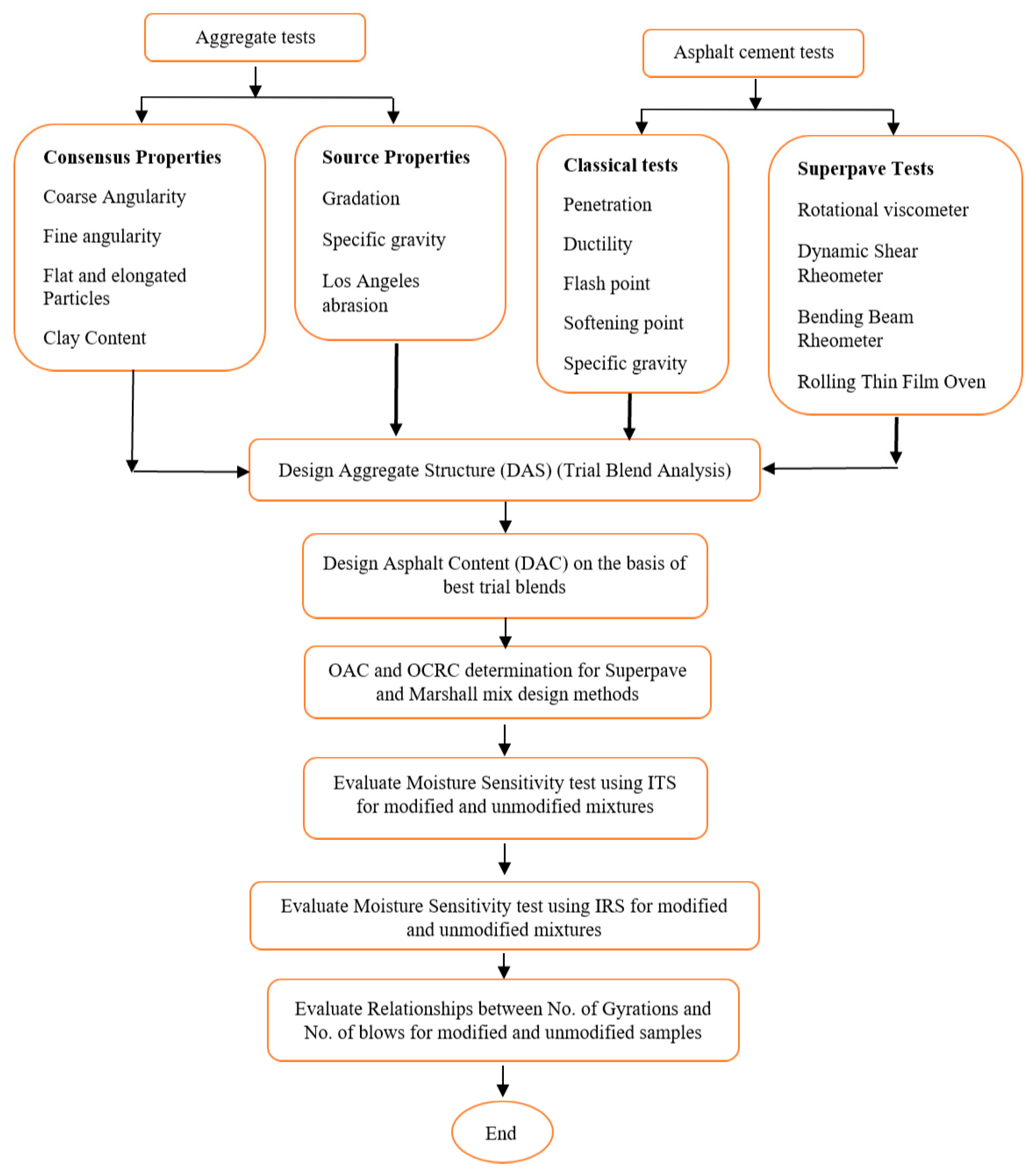
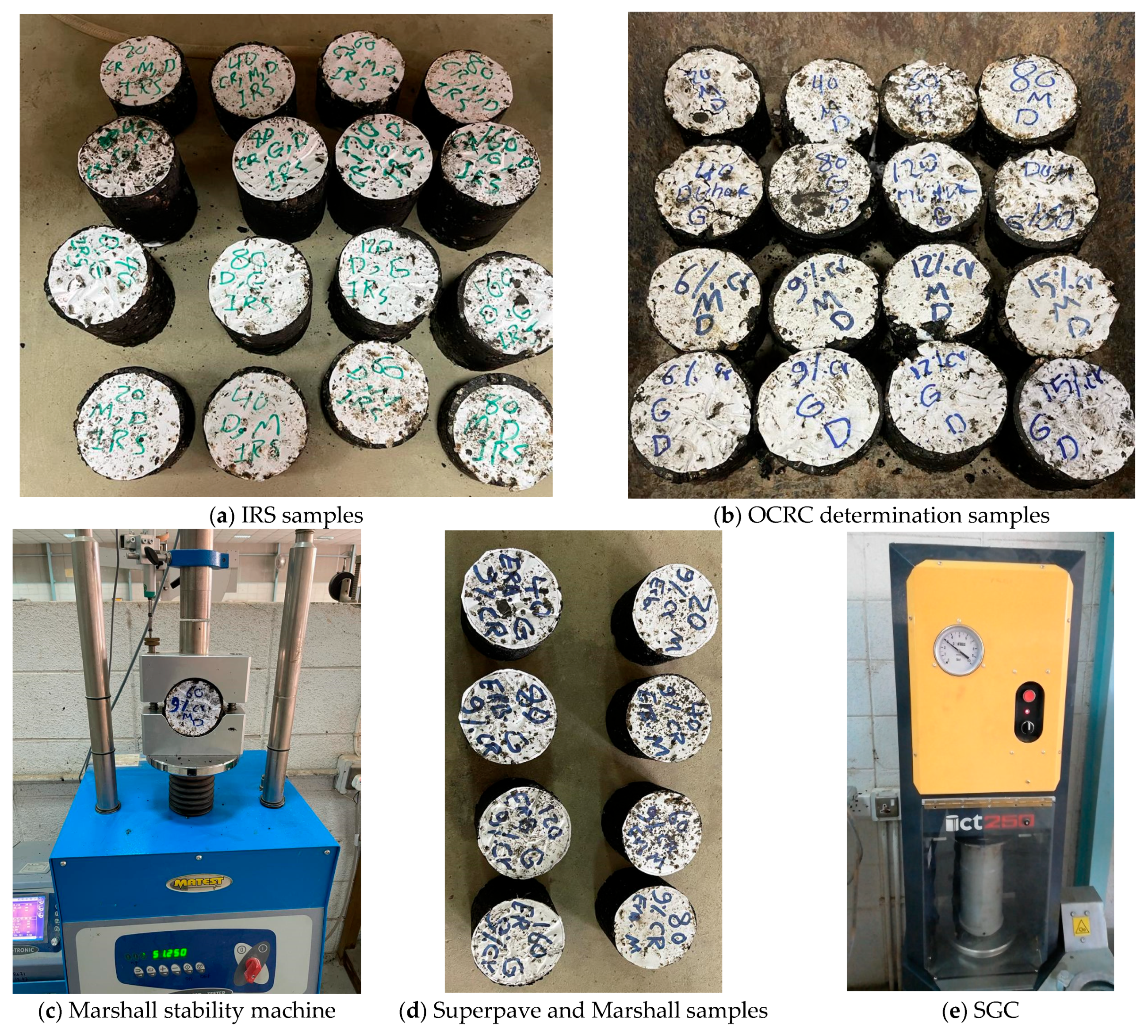
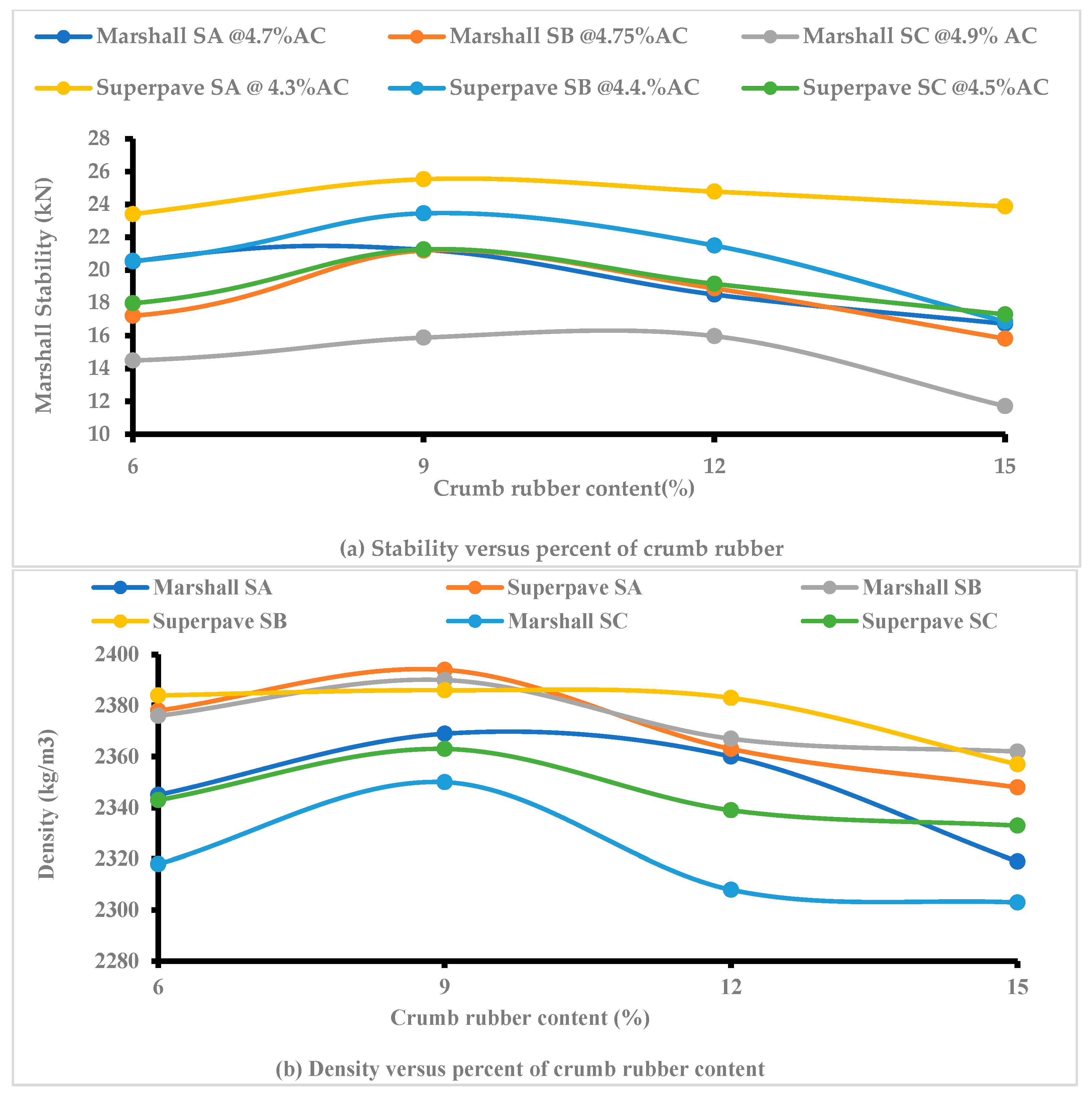
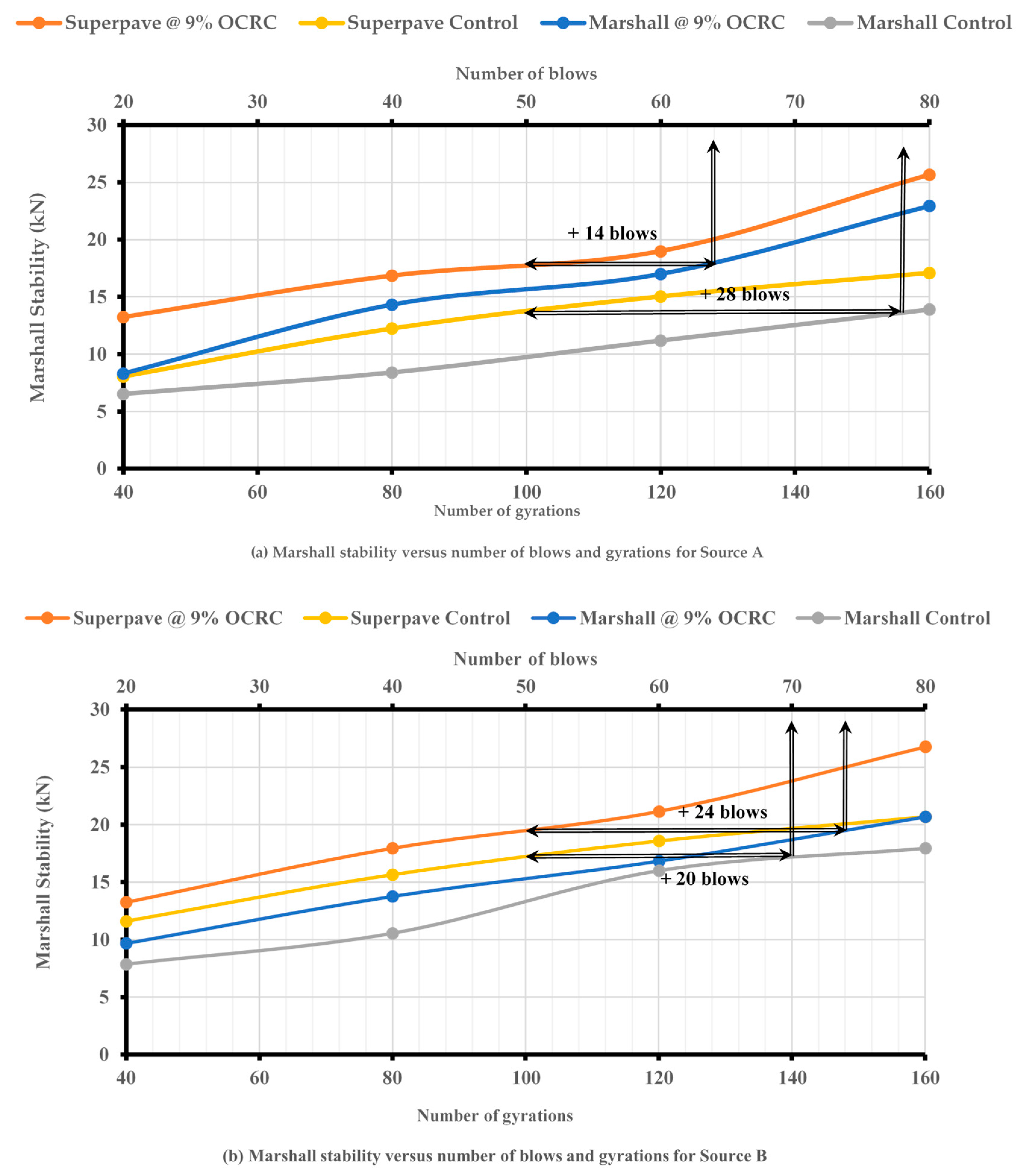
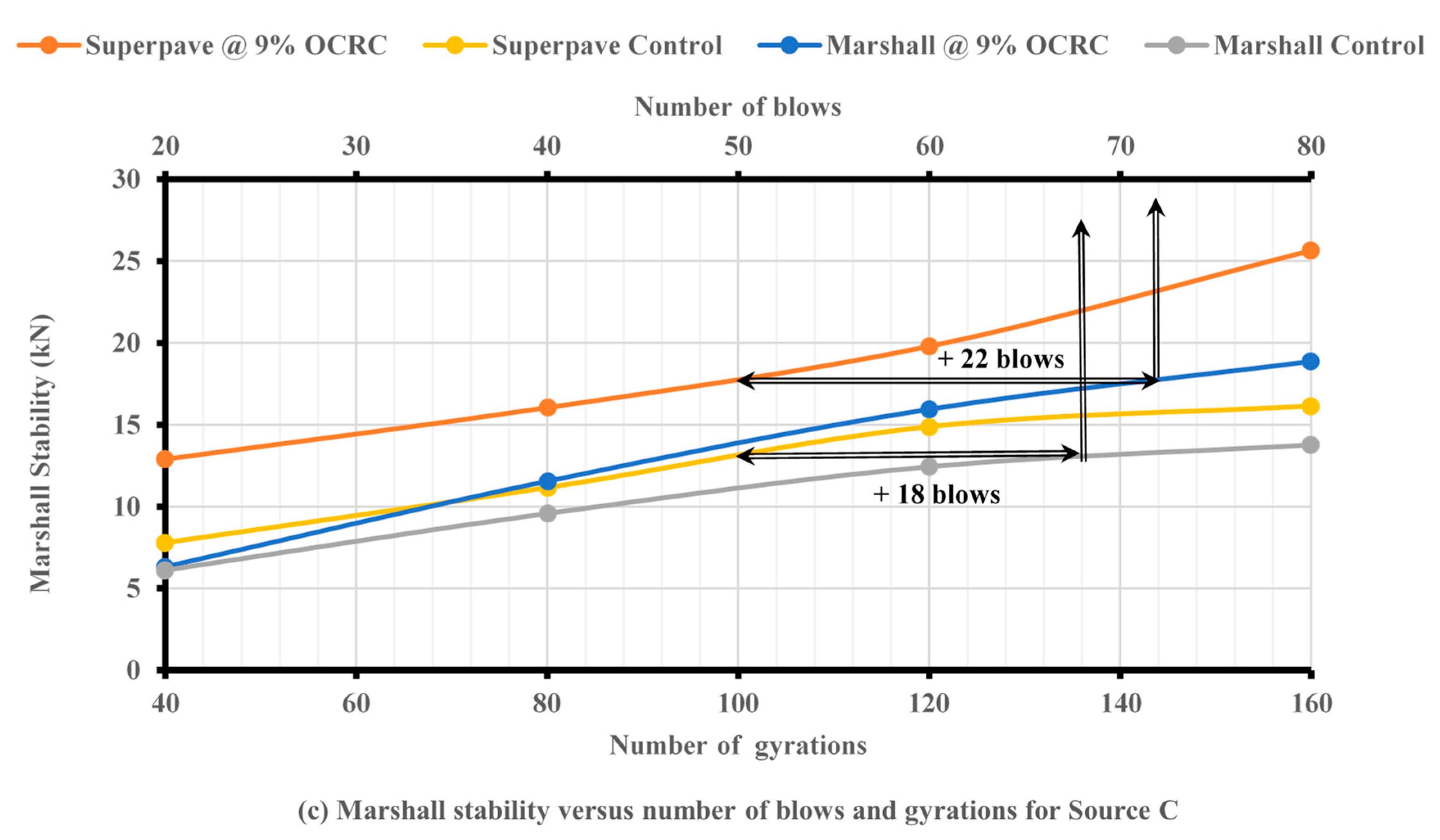
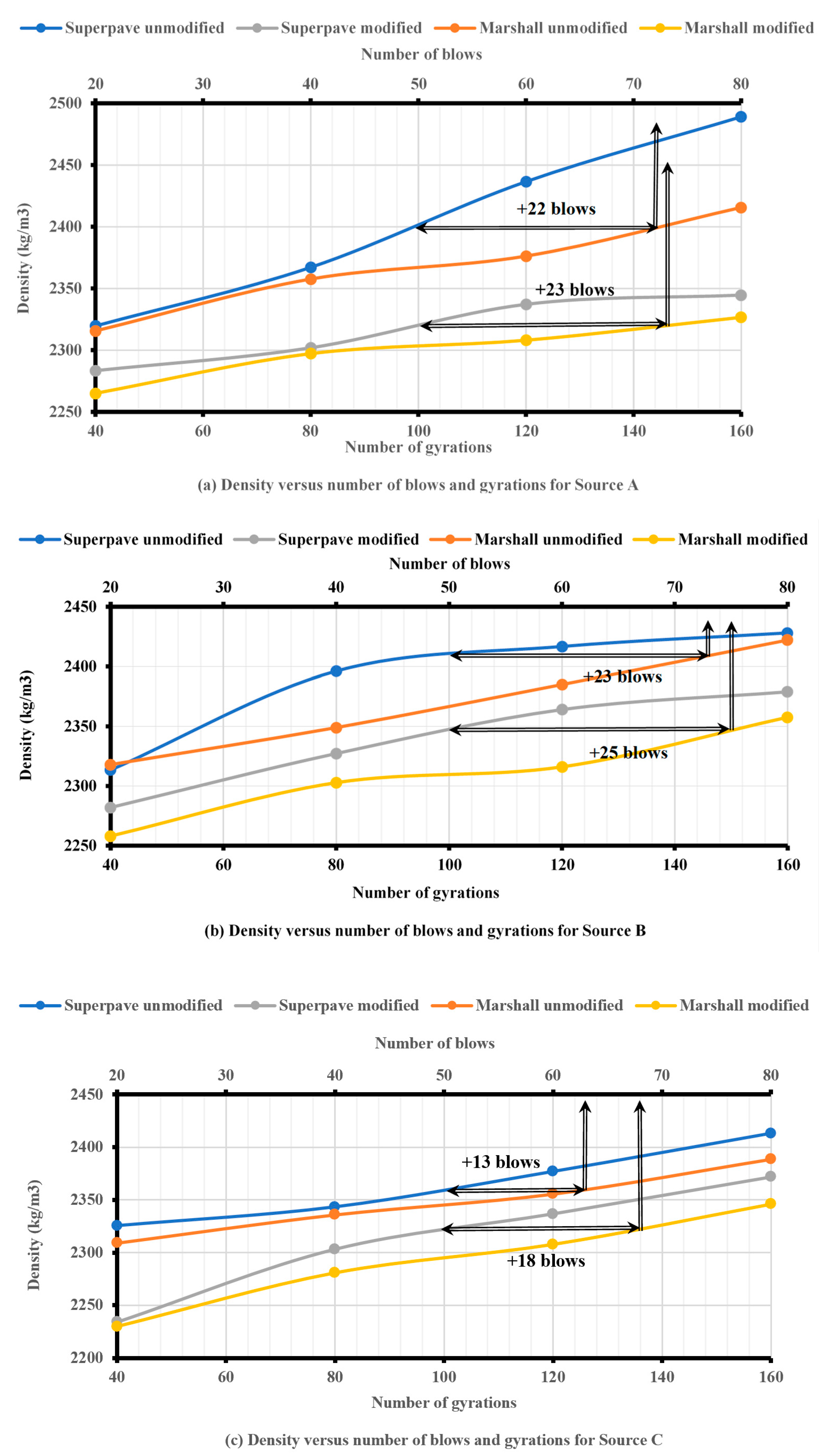
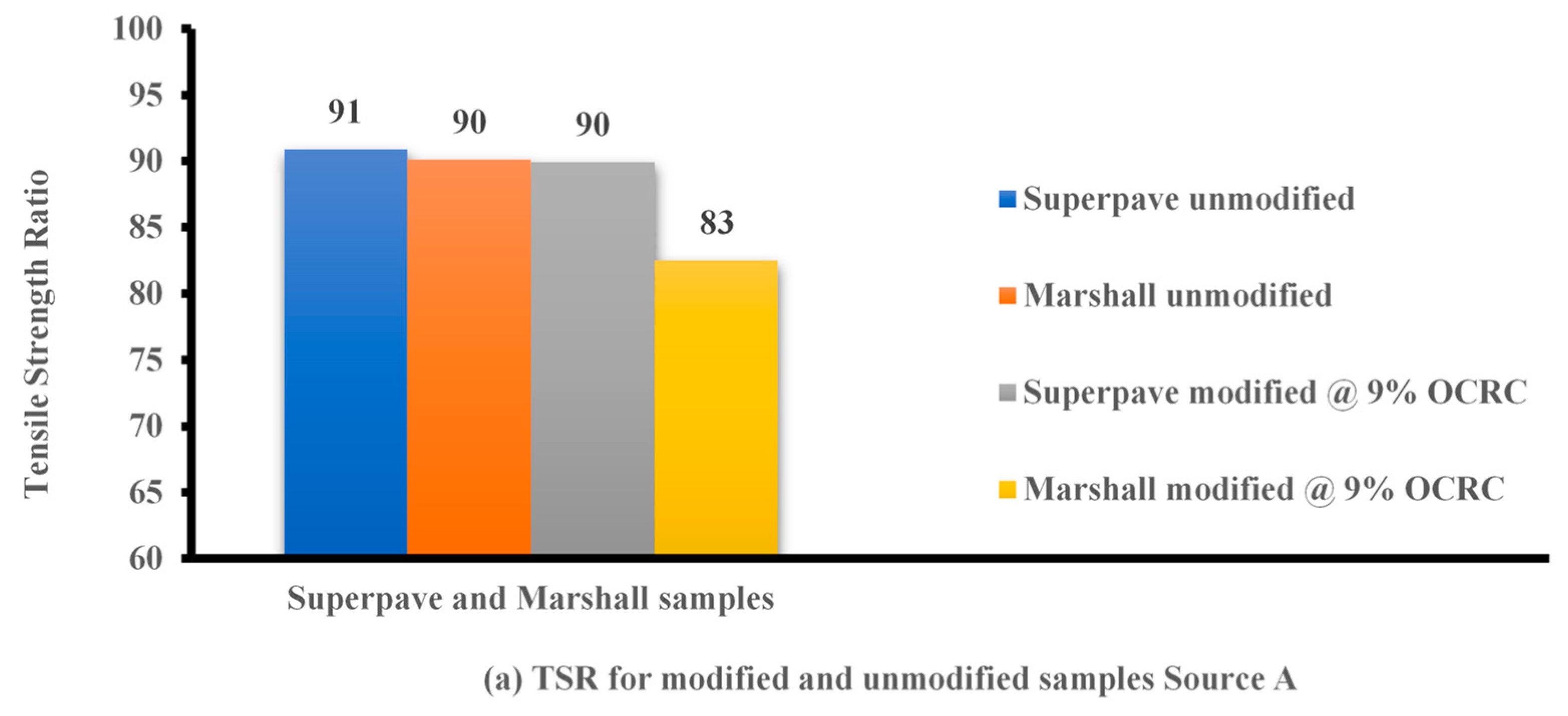
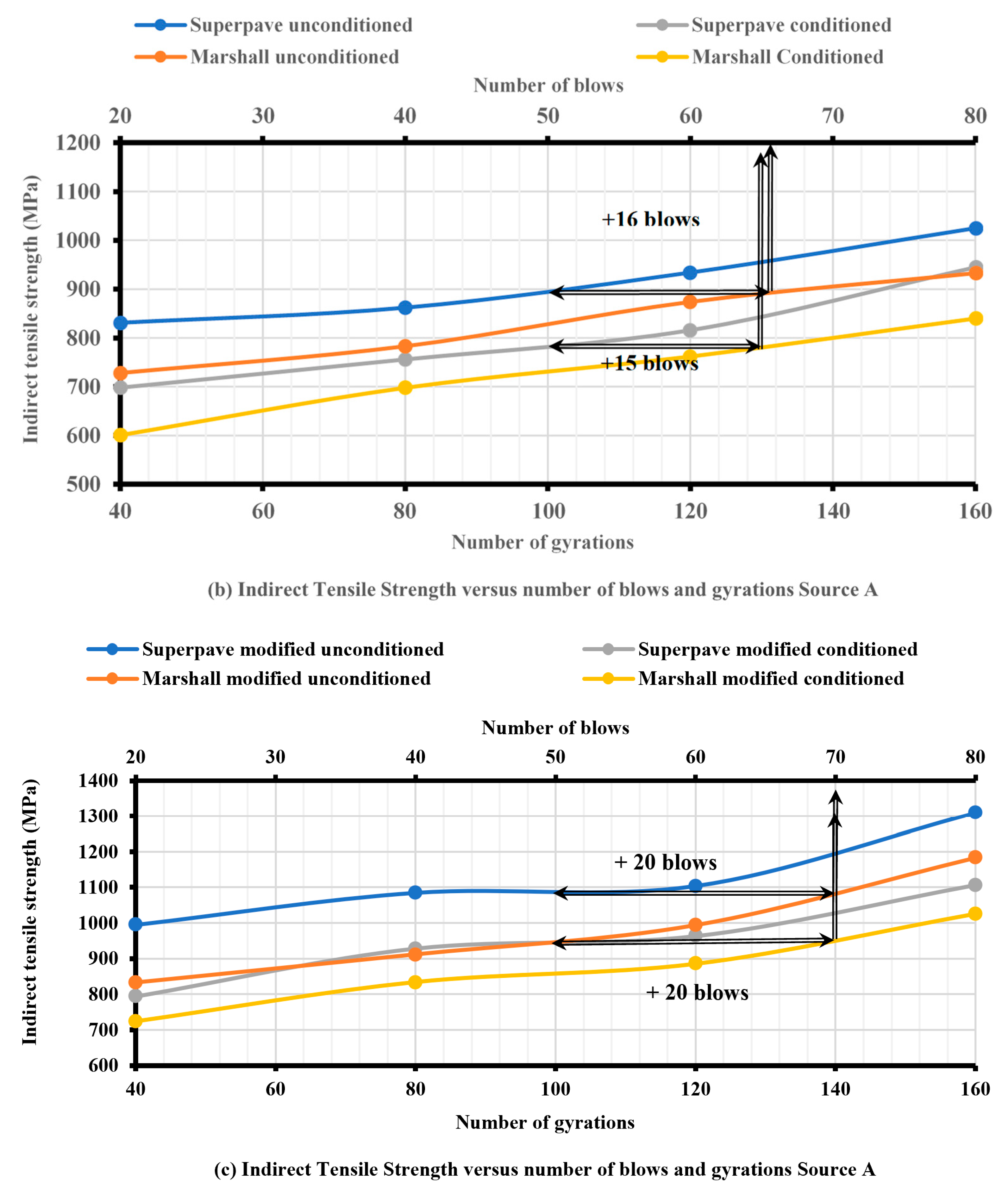
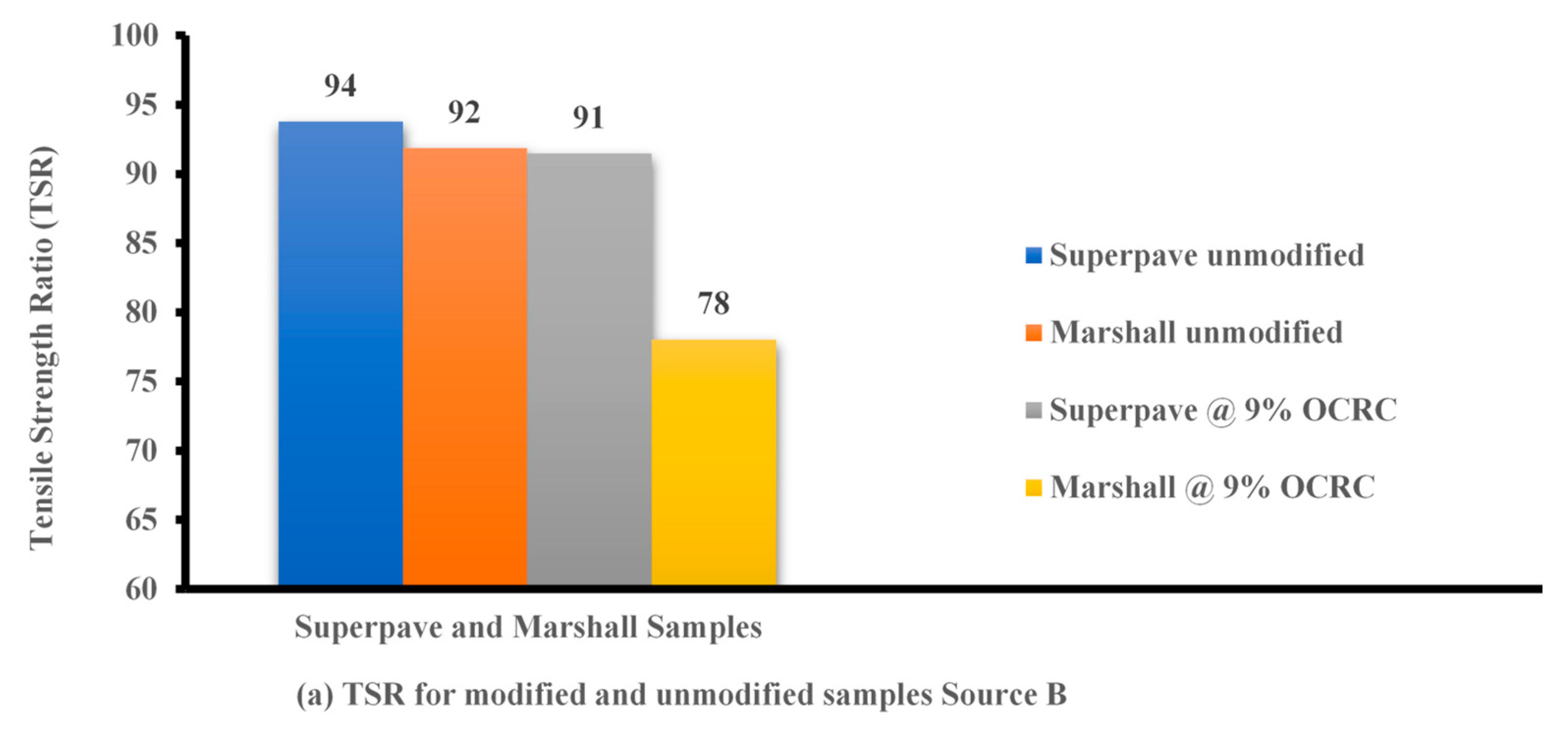
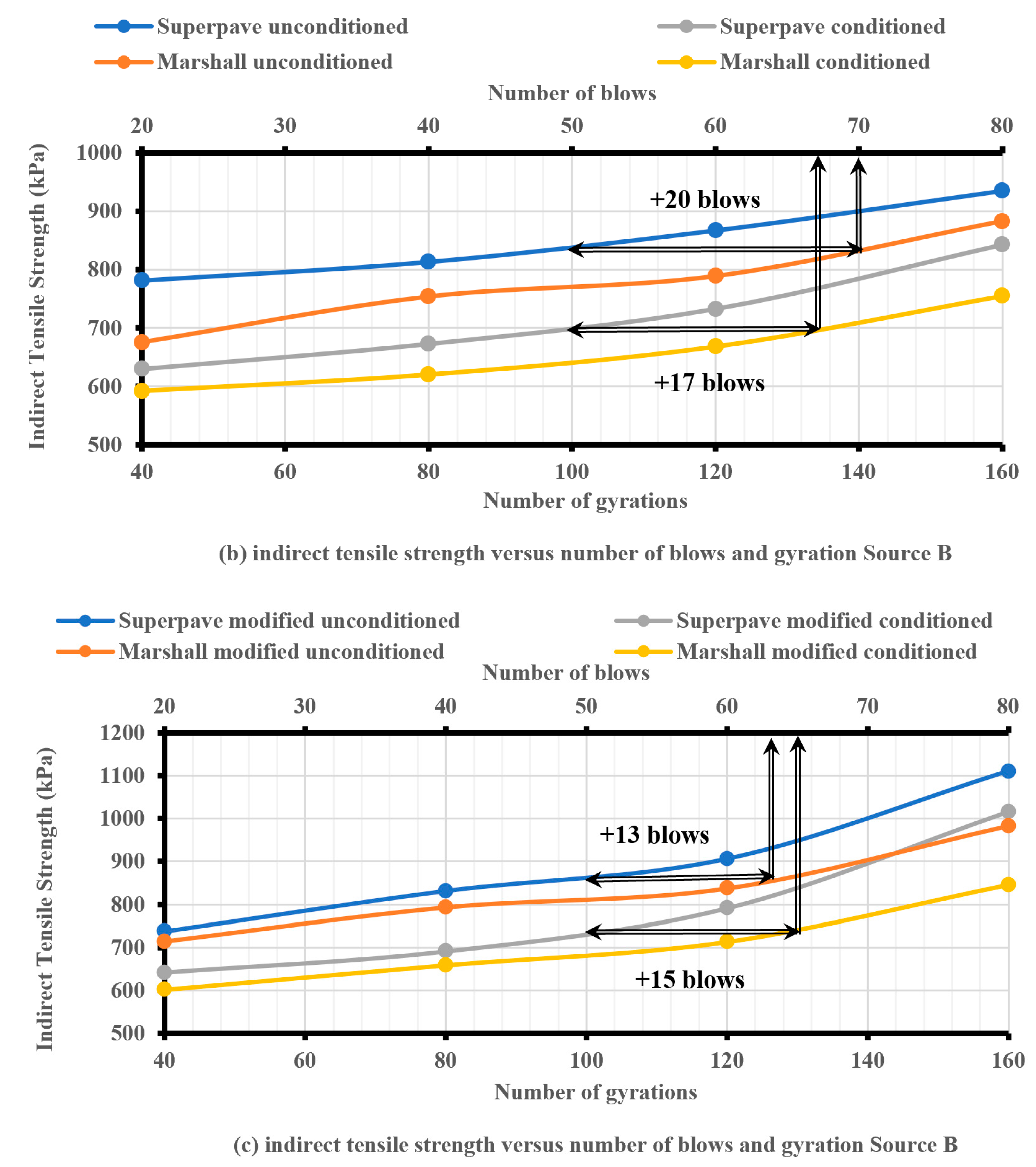


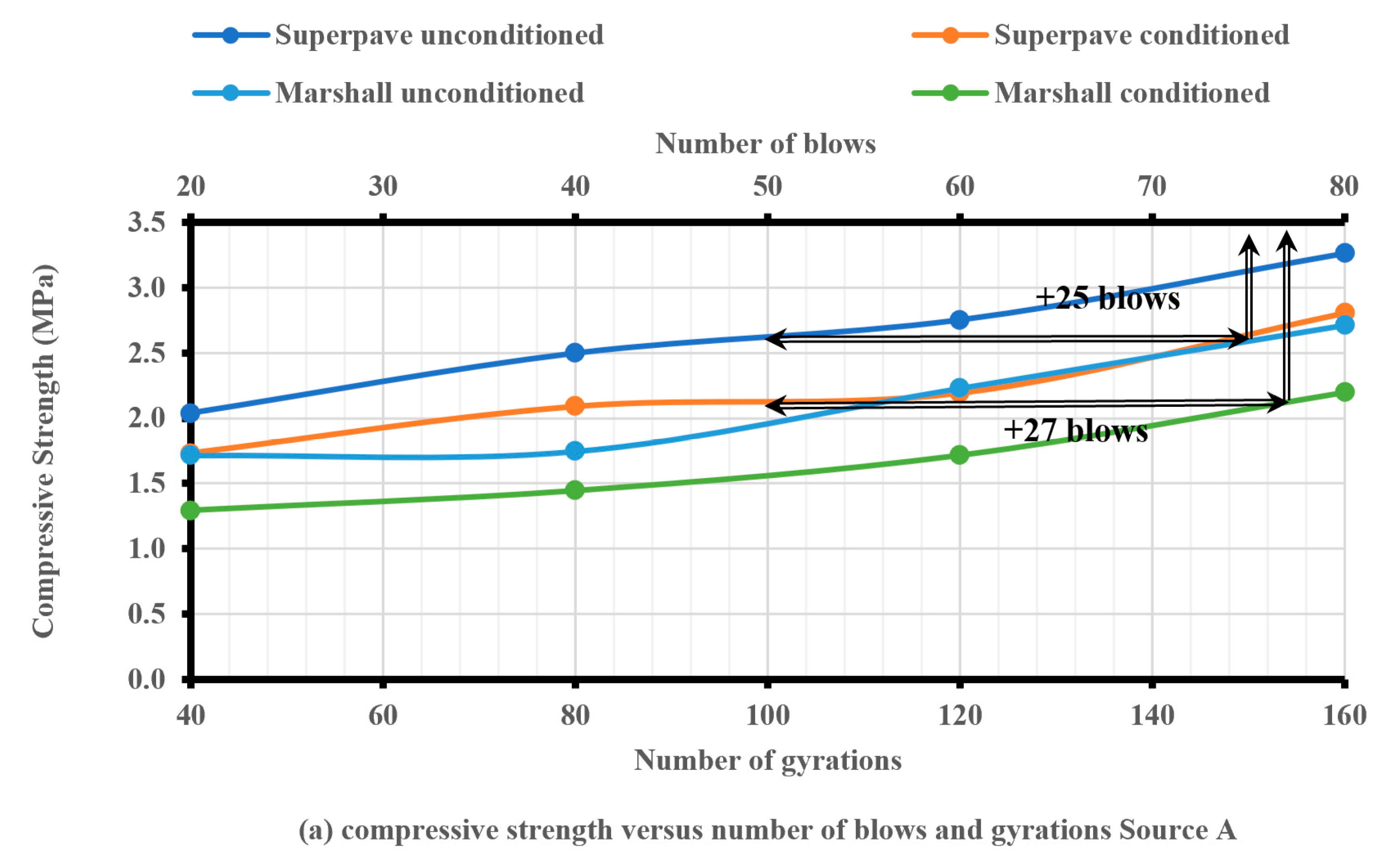
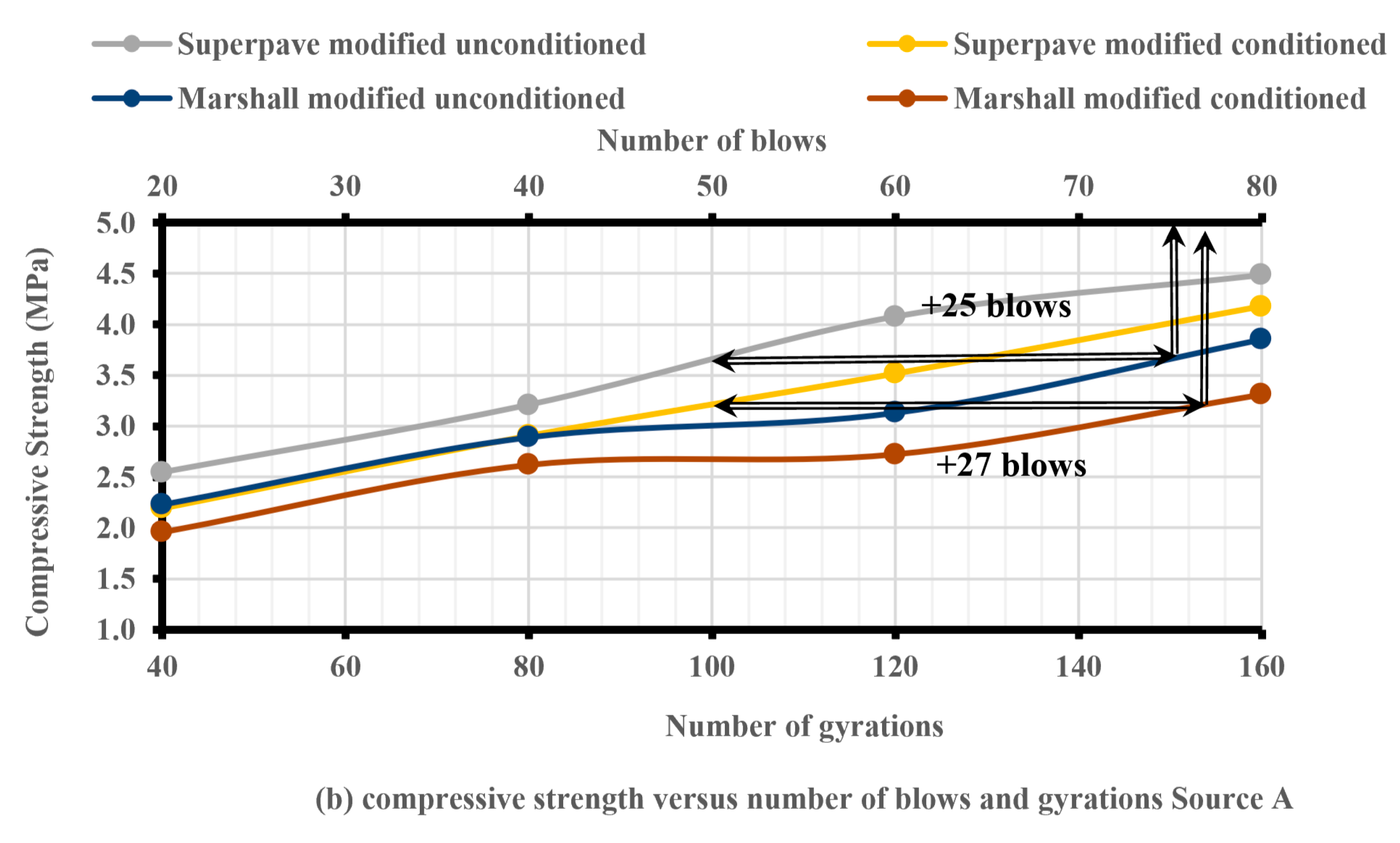
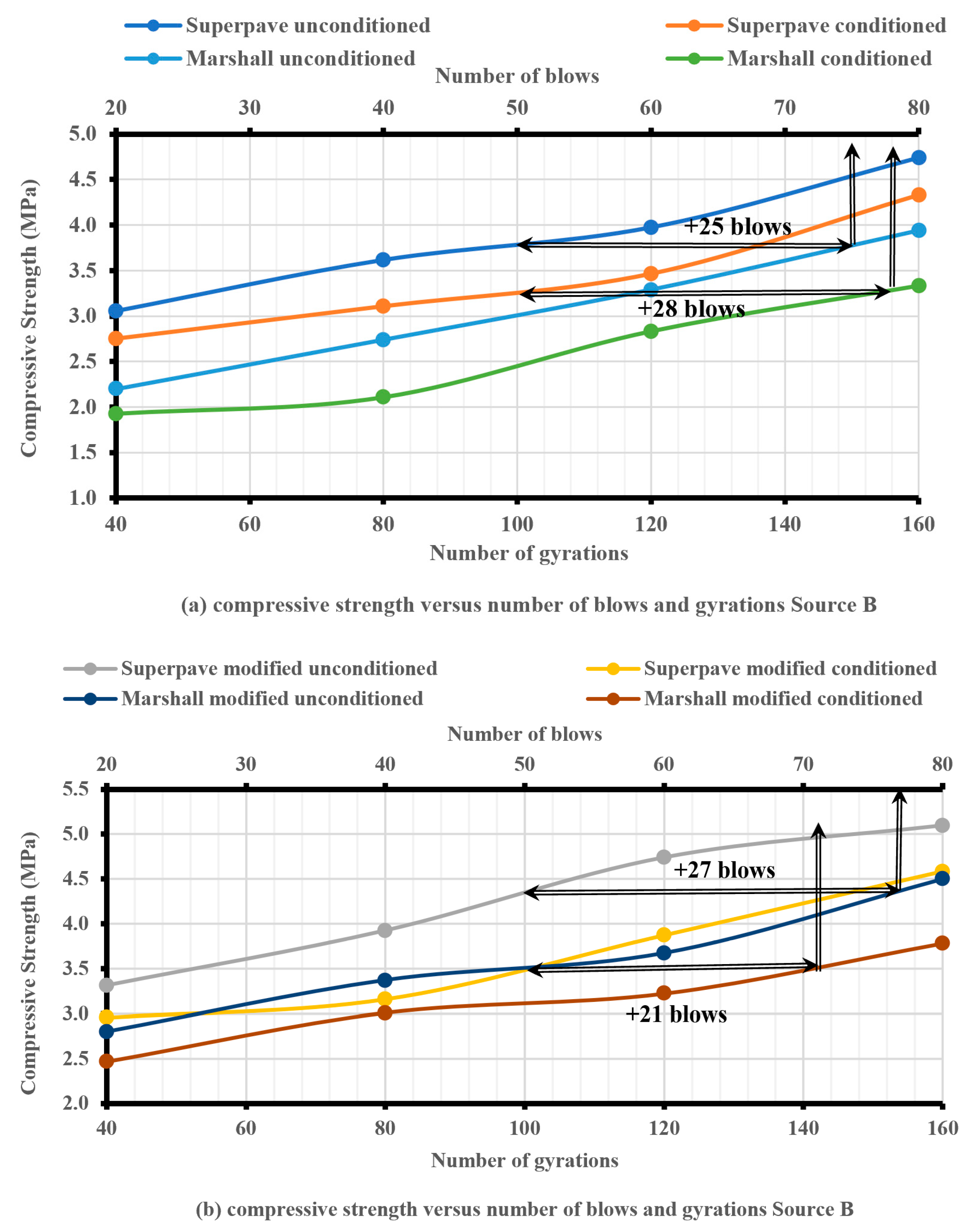
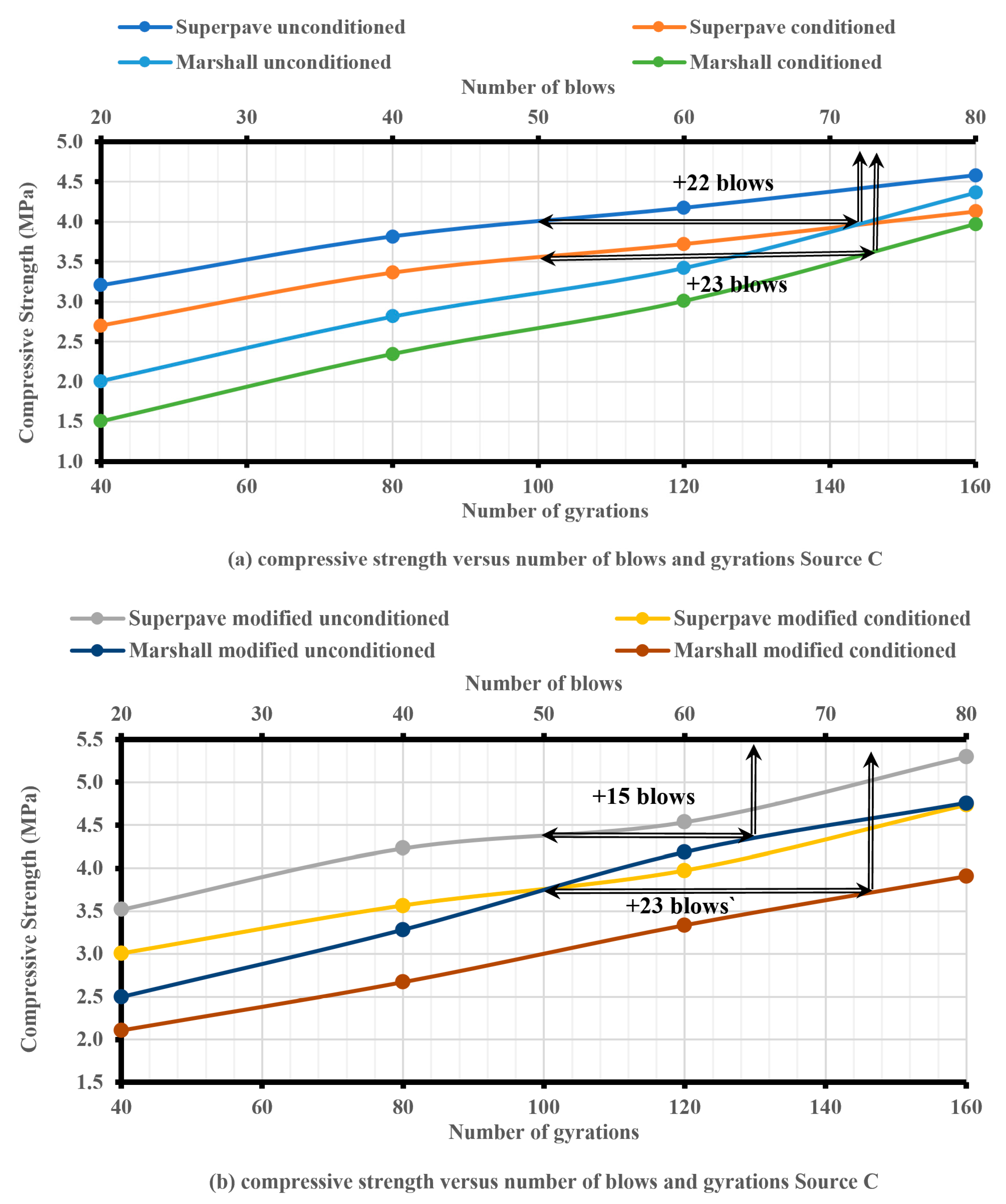

| Aggregate Size | Tests | Standard Specifications | Results | Criteria | ||
|---|---|---|---|---|---|---|
| Source A | Source B | Source C | ||||
| Coarse aggregate | Bulk specific gravity of coarse aggregate | ASTM C127 [35] | 2.675 | 2.583 | 2.622 | n/a |
| Los Angeles abrasion test (%) | ASTM C131 [36] | 14 | 23 | 18 | 35% Max. | |
| Coarse aggregate angularity, at least on fractured face (%) | ASTM D5821 [37] | 97 | 96 | 97 | 95% Min. | |
| Coarse aggregate angularity with more than two fractured faces (%) | 95 | 93 | 97 | 90% Min. | ||
| Percentage of flat particles (%) | ASTM D4791 [38] | 1 | 2 | 1 | 10% Max. | |
| Percentage of flat and elongated particles (%) | 2 | 3 | 0 | 10% Max. | ||
| Fine aggregate | Bulk specific gravity of fine aggregate | ASTM C128 [39] | 2.734 | 2593 | 2.634 | n/a |
| Fine aggregate angularity (%) | ASTM C1252 [40] | 48 | 50 | 49 | 45% Min. | |
| Sand equivalent (clay content) (%) | ASTM D2419 [41] | 81 | 80 | 84 | 45% Min. | |
| Tests | Standard Specifications | Results | Criteria | ||
|---|---|---|---|---|---|
| Source A | Source B | Source C | |||
| Flash point (°C) | ASTM D92 [42] | 265 | 260 | 263 | 230 Min. |
| Penetration at 25 °C (0.1 mm) | ASTM D5 [43] | 47 | 48 | 47 | 40–50 |
| Softening point (°C) | ASTM D36 [44] | 52 | 51 | 52 | 50–58 |
| Ductility at 25 °C (cm) | ASTM D113 [45] | 141 | 133 | 147 | 100 Min. |
| Specific gravity at 25 °C | ASTM D70 [46] | 1.01 | 0.99 | 1.01 | 1.01–1.06 |
| Elastic recovery (%) | ASTM D6084 [47] | 17 | 14 | 15 | n/a |
| Rotational viscosity at 135 °C (Pa·S) | ASTM D4402 [48] | 0.572 | 0.569 | 0.570 | 3 Max. |
| G*/sinδ at 70 °C (not aged) (kPa) | ASTM D7175 [49] | 1.32 | 1.1 | 1.27 | 1.0 Min. |
| G*/sinδ at 70 °C (RTFO) (kPa) | 2.42 | 2.35 | 2.4 | 2.2 Min. | |
| G*sinδ at 31 °C (PAV) (MPa) | 3.1 | 3.0 | 3.09 | 5.0 Max. | |
| Stiffness at −6 °C (PAV) (MPa) | ASTM D6648 [50] | 56 | 62 | 60 | 300 Max. |
| Slope at −6 °C (PAV) | 0.38 | 0.35 | 0.39 | 0.3 Min. | |
| Trial Blends | Sources | Estimated % AC | % Air Voids | % VMA | % VFA | Dust Proportion | % Gmm at Nmax | Satisfy Criteria | Trial Blend Selection |
|---|---|---|---|---|---|---|---|---|---|
| 1 | A | 3.58 | 4 | 16.1 | 75.2 | 0.83 | 96.8 | No | |
| 2 | 4 | 4 | 18.6 | 78.4 | 1 | 97.1 | No | ||
| 3 | 4.2 | 4 | 15.6 | 74.4 | 0.75 | 97.1 | Yes | Selected | |
| 1 | B | 4.58 | 4 | 15.3 | 73.85 | 1.08 | 96.7 | Yes | |
| 2 | 4.7 | 4 | 13.56 | 70.5 | 1.06 | 96 | Yes | Selected | |
| 3 | 4.58 | 4 | 12.76 | 68.65 | 1.05 | 97 | No | ||
| 1 | C | 4.5 | 4 | 13.6 | 70.58 | 0.98 | 96.8 | Yes | Selected |
| 2 | 4.66 | 4 | 15.32 | 73.89 | 0.96 | 96.9 | Yes | ||
| 3 | 4.62 | 4 | 13.84 | 71.1 | 0.95 | 96.7 | Yes | ||
| Superpave Criterion | 4 | 13% Min. | 65–75% | 0.6–1.2 | 98% Max. | ||||
| Sources | Asphalt Content (%) | Marshall Procedure | Superpave Procedure | ||||||
|---|---|---|---|---|---|---|---|---|---|
| Air Void (%) | VMA (%) | VFA (%) | Stability (kN) | Air Void (%) | VMA (%) | VFA (%) | Stability (kN) | ||
| A | 3.7 | 5.83 | 14.28 | 59.16 | 9.55 | 5.13 | 13.93 | 63.18 | 17.80 |
| 4.2 | 4.46 | 13.03 | 65.78 | 13.86 | 4.18 | 15.25 | 75.00 | 18.90 | |
| 4.7 | 4.03 | 12.64 | 68.13 | 12.67 | 3.56 | 18.00 | 80.20 | 16.11 | |
| 5.2 | 3.46 | 12.12 | 71.48 | 11.11 | 2.11 | 17.36 | 87.83 | 12.18 | |
| OAC | 4.70 | 4.30 | |||||||
| B | 4.2 | 6.25 | 14.45 | 56.76 | 15.57 | 4.43 | 14.15 | 68.66 | 16.72 |
| 4.7 | 4.28 | 13.11 | 67.33 | 16.88 | 3.67 | 12.69 | 71.10 | 19.31 | |
| 5.2 | 3.12 | 12.51 | 75.09 | 15.47 | 3.26 | 13.13 | 75.19 | 18.28 | |
| 5.7 | 2.93 | 12.80 | 77.14 | 12.37 | 1.97 | 11.86 | 83.37 | 17.28 | |
| OAC | 4.75 | 4.40 | |||||||
| C | 4 | 7.67 | 14.88 | 48.48 | 11.91 | 4.84 | 13.12 | 63.07 | 12.36 |
| 4.5 | 5.28 | 13.13 | 59.82 | 12.12 | 3.96 | 13.33 | 65.64 | 16.52 | |
| 5 | 3.74 | 12.18 | 69.32 | 13.88 | 2.52 | 11.93 | 78.83 | 15.57 | |
| 5.5 | 3.41 | 12.35 | 72.36 | 11.91 | 1.61 | 11.56 | 86.11 | 13.62 | |
| OAC | 4.9 | 4.5 | |||||||
| Sources | Superpave Samples | Marshall Samples | ||||||
|---|---|---|---|---|---|---|---|---|
| Number of Gyrations | Compressive Strength (MPa) | Number of Blows | Compressive Strength (MPa) | |||||
| Modified | Unmodified | Percentage Increase (%) | Modified | Unmodified | Percentage Increase (%) | |||
| Source A | 40 | 2.55 | 2.04 | 25 | 20 | 2.23 | 1.81 | 23 |
| 80 | 3.21 | 2.50 | 29 | 40 | 2.89 | 2.05 | 41 | |
| 120 | 4.08 | 2.75 | 48 | 60 | 3.13 | 2.35 | 33 | |
| 160 | 4.48 | 3.26 | 38 | 80 | 3.85 | 2.89 | 33 | |
| Source B | 40 | 3.31 | 3.06 | 8 | 20 | 2.80 | 2.20 | 27 |
| 80 | 3.92 | 3.62 | 8 | 40 | 3.37 | 2.74 | 23 | |
| 120 | 4.74 | 3.97 | 19 | 60 | 3.67 | 3.49 | 5 | |
| 160 | 5.10 | 4.74 | 8 | 80 | 3.88 | 3.55 | 9 | |
| Source C | 40 | 3.52 | 3.21 | 10 | 20 | 2.50 | 2.01 | 24 |
| 80 | 4.23 | 3.82 | 11 | 40 | 3.28 | 2.82 | 17 | |
| 120 | 4.54 | 4.18 | 9 | 60 | 4.19 | 3.42 | 22 | |
| 160 | 5.30 | 4.59 | 16 | 80 | 4.76 | 4.37 | 9 | |
Disclaimer/Publisher’s Note: The statements, opinions and data contained in all publications are solely those of the individual author(s) and contributor(s) and not of MDPI and/or the editor(s). MDPI and/or the editor(s) disclaim responsibility for any injury to people or property resulting from any ideas, methods, instructions or products referred to in the content. |
© 2023 by the authors. Licensee MDPI, Basel, Switzerland. This article is an open access article distributed under the terms and conditions of the Creative Commons Attribution (CC BY) license (https://creativecommons.org/licenses/by/4.0/).
Share and Cite
Qadr, D.B.; Talabany, A.F. Compaction Effort Evaluation of Crumb Rubber Modified Hot Mix Asphalt. Sustainability 2023, 15, 7839. https://doi.org/10.3390/su15107839
Qadr DB, Talabany AF. Compaction Effort Evaluation of Crumb Rubber Modified Hot Mix Asphalt. Sustainability. 2023; 15(10):7839. https://doi.org/10.3390/su15107839
Chicago/Turabian StyleQadr, Dlzar Bakr, and Aso Faiz Talabany. 2023. "Compaction Effort Evaluation of Crumb Rubber Modified Hot Mix Asphalt" Sustainability 15, no. 10: 7839. https://doi.org/10.3390/su15107839






